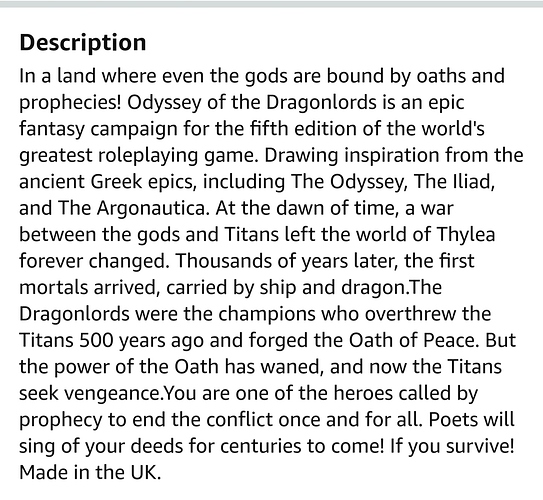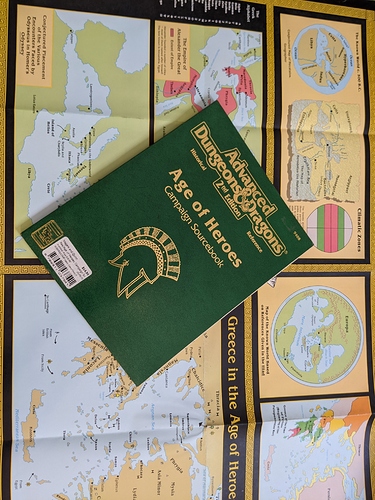So my game that I DM has had some spotty scheduling over the last year or so. Two of my six players are married to each other. They had a kid. Then I had a kid. Then the pandemic hit. Then they had another kid. This upcoming November will mark a year since our last session, and man, the time flies. I finally said “okay, we’re playing on Black Friday, remotely, so let’s get ready for it.” Which means I have to also prepare for it. (We’re probably going to do Roll20 and talk over Google Chat or Discourse. Discord? The video chat thing. Though the integrated video chat in Roll20 is also getting a lot better.)
The last three or four sessions were set in a climatic siege of a town. We’re playing the old Red Hand Of Doom module from 3e grafted into our 5e Greek-themed campaign. I can’t wait to finally finish the battle. That won’t finish the module, but after the battle, there’s only one dungeon crawl left.
I’m looking for advice from some of y’all on how I can improve the last setpiece encounter in this battle.
The last guy is a big brawler guy, the evil general of the evil army. 5e isn’t great for solo strongmen, because the party can surround him and shut him down with their improved action economy. I want to spice up the encounter in a few ways without necessarily giving the villain henchmen, unless it’s a last resort.
Here are a few of my ideas.
-
first, the environment. The setting is in the middle of a public square in front of a temple complex. It’s the middle of the night and it’s been raining. The way the section of the module is structured, the party has fought their way through key parts of this massive siege battle. Now, because of blah blah blah enemy action and counter actions, the general of a massive massive horde wants to fight the party. The ultimate fate of the battle is determined by secret victory points the characters earned during the course of the module, but if the party kills this guy, that will earn them a ton of VP. The two sides of the battle are going to be nearly exhausted, so the rank-and-file of both sides are content to watch how the most powerful people duke it out. They are fine with pausing in the general fighting and creating a space for this encounter. Though if reinforcements do come from either side, that would be easy enough for them to appear. I’m thinking the “battlemap” could slowly shrink as more combatants start crowding to get a better view. (Like the shrinking ritual combat space in the Black Panther movie.) Maybe the evil soldiers could get some kind of automatic hit and damage if a PC moves through an adjacent area. The terrain won’t be too unusual then, though I suppose it doesn’t have to be flat. Maybe there could be a platform or steps or statues as the temple complex rolls down into the agora.
-
For the most part, I’ve been swapping out the original monsters in the 3e module with suitable replacements from the 5e books. But for a really scary villain, I don’t mind spending more effort in prepping it. This guy is the leader of a vast horde of troops (though he is not the BBEG of the module). He’s a hobgoblin, too, so I may need to add a hobbo trait. I’m thinking that the base statblock I want for General Bad Guy is the warlord:
Warlord
Medium humanoid (any race), any alignment
Armor Class 18 (plate)
Hit Points 229 (27d8+108)
Speed 30 ft.
| STR |
DEX |
CON |
INT |
WIS |
CHA |
| 20 (+5) |
16 (+3) |
18 (+4) |
12 (+1) |
12 (+1) |
18 (+4) |
Saving Throws Str +9, Dex +7, Con +8
Skills Athletics +9, Intimidation +8, Perception +5, Persuasion +8
Languages any two languages
Challenge 12 (8,400 XP) (though we use milestones here, we don’t track XP)
Indomitable (3/Day). The warlord can reroll a saving throw it fails. It must use the new roll.
Survivor. The warlord regains 10 hit points at the start of its turn if it has at least 1 hit point but fewer hit points than half its hit point maximum.
_______________ Actions ____________
Multiattack. The warlord makes two weapon attacks.
Greatsword. Melee Weapon Attack: +9 to hit, reach 5 ft., one target. Hit: 12 (2d6+5) slashing damage.
Shortbow. Ranged Weapon Attack: +7 to hit, range 80/320 it, one target. Hit: 6 (1d6+3) piercing damage.
Legendary Actions
The warlord can take 3 legendary actions, choosing from the options below. Only one legendary action option can be used at a time and only at the end of another creature’s turn. The warlord regains spent legendary actions at the start of its turn.
Weapon Attack. The warlord makes a weapon attack.
Command Ally. The warlord targets one ally it can see within 30 feet of it. if the target can see and hear the warlord, the target can make one weapon attack as a reaction and gains advantage on the attack roll.
Frighten Foe (Costs 2 Actions). The warlord targets one enemy it can see within 30 feet of it. If the target can see and hear it, the target must succeed on a DC 16 Wisdom saving throw or be frightened until the end of warlord’s next turn.
BUT I also want to change it up a little to make him even more interesting and hopefully able to survive more than three rounds with the PCs.
First, I want to give him two pools of Hit Points. I want to max out his HP at 324. Half of that is 162. (This might change because the players had already gone through four encounters and have burned a few of their resources already.) When he hits that halfway point, I want to give him what, in 4th edition terms, would be a bloodied status. That would change his abilities. To wit:
In his topmost pool/half of HP, he is a slow-moving heavily armored machine. He has a long spear (greatspear but used one-handed), platemail and a shield. His AC would be 20 instead of 18. He will also be a magnet (so to speak) for the heat metal spell, which at least a few of the PCs still have access to. So I don’t think it will take too long for them to burn down through that first pool of HP.
In his lower half of HP, he discards his plate armor, shield and spear. His AC drops dramatically from 20 down to 13 (no armor + his +3 Dex modifier), but he has new abilities to bring to bear. He starts wielding a magic whip (more on that later). He might get a little faster, maybe to 35 or 40 feet per round? I’d give him different legendary actions at this point, too.
-
Those legendary actions: As stated above, even though one of them explicitly lets him order around minions, I’d prefer to have him get through the fight without using any help. One of them would let him take a move action without triggering opportunity attacks. I suppose that could be available in both his pre-bloodied and bloodied stages.
-
His weapons and attacks: the statblock above mentions a shortbow and greatsword. There’s no room here for ranged weapons. As I said above, I want him to start out in plate armor (imagine a Corinthian type helmet), a really big spear he can use one-handed, and a shield (imagine something big and round, like the kind of shield Sir Mix-A-Lot prefers). I’m not sure if these should be magical also, or if that would be just too potent. But I figure that if anyone is decked out with magical loot, it would be him.
-
His backup, second-stage weapon would be magical. The original module mentioned something that some of the Tiamat-worshiping monsters use called a dragonchain. I haven’t been able to shoehorn that into the adventure yet. This guy is a super-devout Tiamat worshiper, and I’d like him to have something like that. In my conception of it, it’s like a cat-o’-nine-tails, except in keeping with the Tiamat theme, it has five heads. Each head might cause a particular kind of thematic damage (cold, poison, acid, fire, and lightning, just like the five differently-colored heads of a chromatic dragon). I’m also thinking of the magic item Tentacle Rod which looks like this:
Tentacle Rod
Rod, rare (requires attunement)
Made by the drow, this rod is a magic weapon that ends in three rubbery tentacles. While holding the rod, you can use an action to direct each tentacle to attack a creature you can see within 15 feet of you. Each tentacle makes a melee attack roll with a +9 bonus. On a hit, the tentacle deals 1d6 bludgeoning damage. If you hit a target with all three tentacles, it must make a DC 15 Constitution saving throw. On a failure, the creature’s speed is halved, it has disadvantage on Dexterity saving throws, and it can’t use reactions for 1 minute. Moreover, on each of its turns, it can take either an action or a bonus action, but not both. At the end of each of its turns, it can repeat the saving throw, ending the effect on itself on a success.
My math is a little too weak to see what five chains/tentacles would do to balance, especially combined with the “If you hit a target with three chains it might be really messed up for a while” capability. What do you folks, especially those of you with homebrew and mathematics experience, think about that? Would I still require three hits to activate that condition or not?
- Finally, I want to give him something that’s taken a bit from 4th edition and a little from 5th edition. I want to give him a physical “spray” attack with his spear and this magic whip that resembles dragon’s breath. He can do it once, and then would need to roll a recharge. For instance, an Adult White Dragon, which is of similar Challenge Rating/difficulty level, its breath attack looks like this:
Cold Breath (Recharge 5–6). The dragon exhales an icy blast in a 60-foot cone. Each creature in that area must make a DC 19 Constitution saving throw, taking 54 (12d8) cold damage on a failed save, or half as much damage on a successful one.
I don’t think I could justify this guy stabbing with his spear for 60’ but I could for 15’ or maybe even 20’, and it would deal piercing damage instead of cold damage. I suppose the PCs would use a Dex save instead of a Con save to jump out of the way of an expertly aimed barrage of speartips coming at their faces. The damage output also seems a little high here. Maybe I could base it on a Young White Dragon’s breath attack instead.
- And maybe the general has other magic equipment on him, like healing potions, but just as I don’t want to make the battle too short, I don’t want it to turn into a slog if he’s able to heal himself. Hmm, maybe I should get rid of that Survivor regenerating trait, too.
If the characters die and/or flee, they’d have to rely on their existing VP totals to see if the demoralized defenders could push off the remainder of the horde’s onslaught.
If they kill the general, then a sinister Phase Two would be activated, and, to the defenders’ surprise, many of the attackers would start killing themselves for reasons explained later.
If you made it through this wall of text, I really appreciate it. And if you have any feedback, I’d love to hear it.



